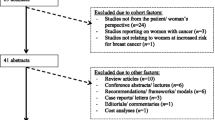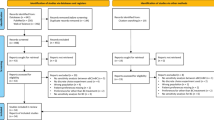Abstract
Purpose
Despite the effectiveness of chemoprevention (tamoxifen and raloxifene) in preventing breast cancer among women at high risk for the disease, uptake is low. The objective of this study was to determine the tradeoff preferences for various attributes associated with chemoprevention among women not currently taking the drugs.
Methods
We used rating-based conjoint analysis to evaluate the relative importance of a number of attributes associated with chemoprevention, including risk of side effects, drug effectiveness, time needed to take the drugs, and availability of a blood test to see if the drugs were working in an Internet sample of women. We generated mean importance values and part-worth utilities for all attribute levels associated with taking chemoprevention. We then used multivariable linear regression to examine attribute importance scores controlling for participant age, race, Hispanic ethnicity, educational level, and a family history of breast cancer.
Results
Overall interest in taking chemoprevention was low among the 1094 women included in the analytic sample, even for the scenario in which participants would receive the greatest benefit and fewest risks associated with taking the drugs. Time needed to take the pill for it to work and 5-year risk of breast cancer were the most important attributes driving tradeoff preferences between the chemoprevention scenarios.
Conclusions
Interest in taking chemoprevention among this sample of women at average risk was low. Addressing women’s concerns about the time needed to take chemoprevention for it to work may help clinicians improve uptake of the drugs among those likely to benefit.

Similar content being viewed by others
References
Siegel RL, Miller KD, Jemal A. Cancer statistics, 2015. CA Cancer J Clin. 2015;65(1):5–29.
Freedman AN, Graubard BI, Rao SR, McCaskill-Stevens W, Ballard-Barbash R, Gail MH. Estimates of the number of US women who could benefit from tamoxifen for breast cancer chemoprevention. J Natl Cancer Inst. 2003;95(7):526–32.
Bevers TB, Armstrong DK, Arun B, Carlson RW, Cowan KH, Daly MB, et al. Breast cancer risk reduction. J Natl Compr Canc Netw. 2010;8(10):1112–46.
Chlebowski RT, Col N, Winer EP, Collyar DE, Cummings SR, Vogel VG, et al. American Society of Clinical Oncology technology assessment of pharmacologic interventions for breast cancer risk reduction including tamoxifen, raloxifene, and aromatase inhibition. J Clin Oncol. 2002;20(15):3328–43.
Kaplan CP, Haas JS, Pérez-Stable EJ, Gregorich SE, Somkin C, Des Jarlais G, et al. Breast cancer risk reduction options: awareness, discussion, and use among women from four ethnic groups. Cancer Epidemiol Biomark. 2006;15(1):162–6.
Ropka ME, Keim J, Philbrick JT. Patient decisions about breast cancer chemoprevention: a systematic review and meta-analysis. J Clin Oncol. 2010;28(18):3090–5.
Melnikow J, Paterniti D, Azari R, Kuenneth C, Birch S, Kuppermann M, et al. Preferences of Women Evaluating Risks of Tamoxifen (POWER) study of preferences for tamoxifen for breast cancer risk reduction. Cancer. 2005;103(10):1996–2005.
Fagerlin A, Zikmund-Fisher BJ, Nair V, Derry HA, McClure JB, Greene S, et al. Women’s decisions regarding tamoxifen for breast cancer prevention: responses to a tailored decision aid. Breast Cancer Res Treat. 2010;119(3):613–20.
Waters EA, McNeel TS, Stevens WM, Freedman AN. Use of tamoxifen and raloxifene for breast cancer chemoprevention in 2010. Breast Cancer Res Treat. 2012;134(2):875–80.
Armstrong K, Quistberg DA, Micco E, Domchek S, Guerra C. Prescription of tamoxifen for breast cancer prevention by primary care physicians. Arch Intern Med. 2006;166(20):2260–5.
Vogel VG, Costantino JP, Wickerham DL, Cronin WM, Cecchini RS, Atkins JN, et al. Update of the National Surgical Adjuvant Breast and Bowel Project Study of Tamoxifen and Raloxifene (STAR) P-2 Trial: preventing breast cancer. Cancer Prev Res (Phila). 2010;3(6):696–706.
Fisher B, Costantino JP, Wickerham DL, Redmond CK, Kavanah M, Cronin WM, et al. Tamoxifen for prevention of breast cancer: report of the National Surgical Adjuvant Breast and Bowel Project P-1 Study. J Natl Cancer Inst. 1998;90(18):1371–88.
Cooke AL, Metge C, Lix L, Prior HJ, Leslie WD. Tamoxifen use and osteoporotic fracture risk: a population-based analysis. J Clin Oncol. 2008;26(32):5227–32.
Nichols HB, DeRoo LA, Scharf DR, Sandler DP. Risk-benefit profiles of women using tamoxifen for chemoprevention. J Natl Cancer Inst. 2015;107(1):354.
Bastian LA, Lipkus IM, Kuchibhatla MN, Weng HH, Halabi S, Ryan PD, et al. Women’s interest in chemoprevention for breast cancer. Arch Intern Med. 2001;161(13):1639–44.
Bober SL, Hoke LA, Duda RB, Regan MM, Tung NM. Decision-making about tamoxifen in women at high risk for breast cancer: clinical and psychological factors. J Clin Oncol. 2004;22(24):4951–7.
Fasching PA, Von Minckwitz G, Fischer T, Kaufmann M, Schultz-Zehden B, Beck H, et al. The impact of breast cancer awareness and socioeconomic status on willingness to receive breast cancer prevention drugs. Breast Cancer Res Treat. 2007;101(1):95–104.
Port ER, Montgomery LL, Heerdt AS, Borgen PI. Patient reluctance toward tamoxifen use for breast cancer primary prevention. Ann Surg Oncol. 2001;8(7):580–5.
Heisey R, Pimlott N, Clemons M, Cummings S, Drummond N. Women’s views on chemoprevention of breast cancer: qualitative study. Can Fam Physician. 2006;52:624–5.
Wei MY, Ito MK, Cohen JD, Brinton EA, Jacobson TA. Predictors of statin adherence, switching, and discontinuation in the USAGE survey: understanding the use of statins in America and gaps in patient education. J Clin Lipidol. 2013;7(5):472–83.
Nantz E, Liu-Seifert H, Skljarevski V. Predictors of premature discontinuation of treatment in multiple disease states. Patient Prefer Adherence. 2009;3:31–43.
Mulley AG, Sepucha K. Making good decisions about breast cancer chemoprevention. Ann Intern Med. 2002;137(1):52–4.
Owens WL, Gallagher TJ, Kincheloe MJ, Ruetten VL. Implementation in a large health system of a program to identify women at high risk for breast cancer. J Oncol Pract. 2011;7(2):85–8.
Evans DG, Barwell J, Eccles DM, Collins A, Izatt L, Jacobs C, et al. The Angelina Jolie effect: how high celebrity profile can have a major impact on provision of cancer related services. Breast Cancer Res. 2014;16(5):442.
Hutchins R, Viera AJ, Sheridan SL, Pignone MP. Quantifying the utility of taking pills for cardiovascular prevention. Circ Cardiovasc Qual Outcomes. 2015;8(2):155–63.
Luce RD, Tukey JW. Simultaneous conjoint measurement: a new type of fundamental measurement. J Math Psychol. 1964;1:1–27.
Ryan M, Scott D, Reeves C, Bate A, van Teijlingen E, Russell E, et al. Eliciting public preferences for healthcare: a systematic review of techniques. Health Technol Assess (Rockv). 2001;5(5):1–186.
Curry J. Understanding conjoint analysis in 15 minutes. Sequim: Sawtooth Software, Inc.; 1996.
Bridges JFP, Hauber AB, Marshall D, Lloyd A, Prosser LA, Regier DA, et al. Conjoint analysis applications in health—a checklist: a report of the ISPOR Good Research Practices for Conjoint Analysis Task Force. Value Health. 2011;14(4):403–13.
Tanner AE, Katzenstein JM, Zimet GD, Cox DS, Cox AD, Fortenberry JD. Vaginal microbicide preferences among midwestern urban adolescent women. J Adolesc Health. 2008;43(4):349–56.
Cai QF, Wan F, Dong XY, Liao XH, Zheng J, Wang R, et al. Fertility clinicians and infertile patients in China have different preferences in fertility care. Hum Reprod. 2014;29(4):712–9.
Orme B. Formulating attributes and levels in conjoint analysis. Sequin: Sawtooth Software, Inc.; 2002.
Fagerlin A, Dillard AJ, Smith DM, Zikmund-Fisher BJ, Pitsch R, McClure JB, et al. Women’s interest in taking tamoxifen and raloxifene for breast cancer prevention: response to a tailored decision aid. Breast Cancer Res Treat. 2011;127(3):681–8.
Wouters H, Van Dijk L, Van Geffen ECG, Gardarsdottir H, Stiggelbout AM, Bouvy ML. Primary-care patients’ trade-off preferences with regard to antidepressants. Psychol Med. 2014 (Epub 7 Jan).
Ryan M. Using conjoint analysis to take account of patient preferences and go beyond health outcomes: an application to in vitro fertilisation. Soc Sci Med. 1999;48(4):535–46.
Dillard AJ, Scherer L, Ubel PA, Smith DM, Zikmund-Fisher BJ, McClure JB, et al. Breast cancer anxiety’s associations with responses to a chemoprevention decision aid. Soc Sci Med. 2013;77:13–9.
Sedrakyan A, Shih C. Improving depiction of benefits and harms: analyses of studies of well-known therapeutics and review of high-impact medical journals. Med Care. 2007;45(10 Suppl 2):S23–8.
Griffith JM, Lewis CL, Hawley S, Sheridan SL, Pignone MP. Randomized trial of presenting absolute v. relative risk reduction in the elicitation of patient values for heart disease prevention with conjoint analysis. Med Decis Mak. 2009;29(2):167–74.
Trevena LJ, Zikmund-Fisher BJ, Edwards A, Gaissmaier W, Galesic M, Han PKJ, et al. Presenting quantitative information about decision outcomes: a risk communication primer for patient decision aid developers. BMC Med Inform Decis Mak. 2013;13(Suppl 2):S7.
Mann DM, Allegrante JP, Natarajan S, Halm EA, Charlson M. Predictors of adherence to statins for primary prevention. Cardiovasc Drugs Ther. 2007;21(4):311–6.
Claxton AJ, Cramer J, Pierce C. A systematic review of the associations between dose regimens and medication compliance. Clin Ther. 2001;23(8):1296–310.
Reginster JY, Rabenda V, Neuprez A. Adherence, patient preference and dosing frequency: understanding the relationship. Bone. 2006;38(4 Suppl 1):S2–6.
Orme BK, Alpert MI, Christensen E. Assessing the validity of conjoint analysis—continued. Sequin: Sawtooth Software Inc.; 1997.
Louviere J. Stated choice methods: analysis and application. Cambridge: Cambridge University Press; 2000.
Kaplan CP, Kim SE, Wong ST, Sawaya GF, Walsh JME, Pérez-Stable EJ. Willingness to use tamoxifen to prevent breast cancer among diverse women. Breast Cancer Res Treat. 2012;133(1):357–66.
Campitelli MA, Chiarelli AM, Mirea L, Stewart L, Glendon G, Ritvo P, et al. Adherence to breast and ovarian cancer screening recommendations for female relatives from the Ontario site of the Breast Cancer Family Registry. Eur J Cancer Prev. 2011;20(6):492–500.
Chrzan K, Orme B. An overview and comparison of design stratgies for choice-based conjoint analysis. Sequim: Sawtooth Software, Inc.; 2000.
Nair V, Strecher V, Fagerlin A, Ubel P, Resnicow K, Murphy S, et al. Screening experiments and the use of fractional factorial designs in behavioral intervention research. Am J Public Health. 2008;98(8):1354–9.
Orme B. Interpreting conjoint analysis data. Software Research Paper Series 2002. Sequin: Sawtooth Software, Inc.; 2002.
Wouters H, Maatman GA, Van Dijk L, Bouvy ML, Vree R, Van Geffen ECG, et al. Trade-off preferences regarding adjuvant endocrine therapy among women with estrogen receptor-positive breast cancer. Ann Oncol. 2013;24(9):2324–9.
Flynn TN. Valuing citizen and patient preferences in health: recent developments in three types of best-worst scaling. Expert Rev Pharmacoecon Outcomes Res. 2010;10(3):259–67.
Persky S, Kaphingst KA, Condit CM, McBride CM. Assessing hypothetical scenario methodology in genetic susceptibility testing analog studies: a quantitative review. Genet Med. 2007;9(11):727–38.
Author Contributions
Angela Fagerlin, Holly Witteman, Christine Holmberg, and Sarah Hawley conceptualized and designed the study, including the online rating-based conjoint exercise. Kathryn Martinez and Holly Witteman conducted data analysis. All authors assisted in interpreting the results. The complete first draft of the paper was written by Kathryn Martinez, with assistance from Angela Fagerlin and Sarah Hawley. All authors commented on the first complete draft as well as subsequent versions. Kathryn Martinez acts as guarantor for the paper.
Author information
Authors and Affiliations
Corresponding author
Ethics declarations
Funding
This study was funded by the National Institutes for Health (R01 CA87595 and P50 CA101451). Dr. Martinez was supported by a postdoctoral fellowship from the US Department of Veterans Affairs.
Conflicts of Interest
Kathryn Martinez, Angela Fagerlin, Holly Witteman, Christine Holmberg, and Sarah Hawley have no conflicts of interest to disclose.
Rights and permissions
About this article
Cite this article
Martinez, K.A., Fagerlin, A., Witteman, H.O. et al. What Matters to Women When Making Decisions About Breast Cancer Chemoprevention?. Patient 9, 149–159 (2016). https://doi.org/10.1007/s40271-015-0134-z
Published:
Issue Date:
DOI: https://doi.org/10.1007/s40271-015-0134-z




